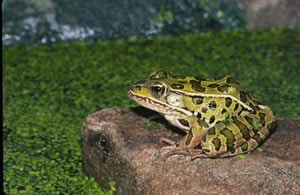The Northern Leopard Frog is not that common in Connecticut. Its skin can be light brown or green with distinct, rounded, dark spots. Its belly is white as is the skin under the legs. Leopard frogs can be 2 to 5 inches long.
Northern leopard frogs and pickerel frogs are sometimes confused. A pickerel frog is never green. It has orange-yellow skin under its legs. Its spots are squarish. A leopard frog can be green or brown. The skin under its legs is white. Its spots are rounded.
Northern leopard frogs range through the northern US, except for the west, and through southern Canada except for the west. They are a species of Special Concern in Connecticut where only smaller, localized populations exist. They are mostly found along some sections of the Connecticut River. They are intolerant of acidic conditions and tend to be in the areas of Connecticut where there is limestone. Adults inhabit seasonally wet meadows and forests and are usually living on the floodplains near rivers or large streams. Tadpoles live in the water until they reach maturity. Leopard frogs are active during the warm season and hibernate for the winter underwater. They spend the winter buried in the mud on the bottom of a well-oxygenated waterbody. These frogs cannot tolerate being frozen, as some can. They are active in the day and in the night.
Adult leopard frogs primarily eat insects. They will eat other creatures too if they are small enough. They hunt bugs by shooting out their sticky tongue to trap an insect and draw it back into their mouth. Their diet includes insects, snails, and earthworms. Immature leopard frogs, tadpoles, feed on plant matter.
Leopard frogs emerge from hibernation in late winter or early spring. Mating season is in April. Leopard frogs seek out lakes, ponds or temporary pools for breeding. Male leopard frogs sing mating calls to attract a mate. A male grabs the female around her chest with his front legs and clings until she lays her eggs in the water. He deposits sperm on top of them. The female leopard frog produces up to 6000 eggs in a gelatinous mass as a film or a clump attached to submerged vegetation. In 2 to 3 weeks the eggs hatch into tadpoles. It can take 3 to 4 months for the tadpoles to absorb their tails, grow legs and develop lungs. Tadpoles live only in the water. Adult leopard frogs tend to stay in very moist areas near water.
Leopard frogs are solitary, except when they congregate in breeding waters in the spring. The mating calls of the males sound like a series of rapid clicks interspersed with a buzzy, chuckling rasp. Click the leopard frog call under the photo for an example. Don't mistake the piercing high-pitched peeping for the leopard frogs, those are spring peepers. The leopard frogs are making the more muted clicking and buzzy sounds.
Frogs produce their calls by inflating part of their mouth lining under their throat with air through an opening in the bottom of their mouths. They then close off their mouths and nostrils and pump air between their lungs and this vocal sac over their vocal chords. The vocal sac of a calling frog is clearly visible as a bubble under his throat.
Neat Facts
There are two color mutations found in the northern leopard frog species. The Burnsi leopard frog lacks spots. The Kandiyohi leopard frog is mostly dark with flecks of lighter brown.
